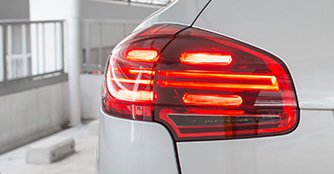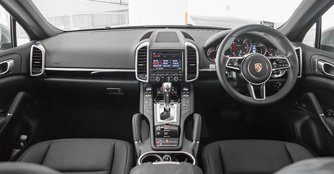Porsche Cayenne Diesel 3.0 (A) Facelift Review
13 Apr 2015|12,102 views
It was once said that people wouldn't be interested in a Porsche unless it has a 'pancake' motor mounted on the wrong side (at the rear) of the car.
In fact, earlier models, such as the 914 - a two-seater roadster, which was the result of a joint project with Volkswagen, and the lineup of front-engined sports cars, ranging from the 924 to the 968 - were nowhere as successful as the 911.
But it seems that the tide has changed. When Porsche launched the Cayenne SUV, brows were raised but the car became a sales success overnight, outselling sporty models like the Boxster and Cayman, and even the iconic and highly desirable 911.
Now in its second generation, the Cayenne remains to be one of the marque's best-selling models. But while the facelift version is available in no fewer than six 'flavours', there should be no doubt that it's this diesel variant that will top the sales chart.
Up close and Personal
Much of the Cayenne's proportions and design have been left unchanged in this latest iteration. Despite sporting a more angular look (thanks to the redesigned air inlets and crisp lines running down its bonnet), the SUV isn't overly sporty by any measure.
In fact, earlier models, such as the 914 - a two-seater roadster, which was the result of a joint project with Volkswagen, and the lineup of front-engined sports cars, ranging from the 924 to the 968 - were nowhere as successful as the 911.
But it seems that the tide has changed. When Porsche launched the Cayenne SUV, brows were raised but the car became a sales success overnight, outselling sporty models like the Boxster and Cayman, and even the iconic and highly desirable 911.
Now in its second generation, the Cayenne remains to be one of the marque's best-selling models. But while the facelift version is available in no fewer than six 'flavours', there should be no doubt that it's this diesel variant that will top the sales chart.
Up close and Personal
Much of the Cayenne's proportions and design have been left unchanged in this latest iteration. Despite sporting a more angular look (thanks to the redesigned air inlets and crisp lines running down its bonnet), the SUV isn't overly sporty by any measure.
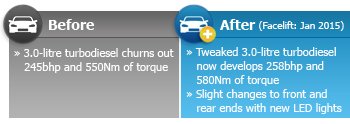 |
In fact, it's easy to find more aggressive-looking models, such as the BMW X5 and Jeep Grand Cherokee, which make the Cayenne's rounded overalls looks tame in comparison.
It is also tough to tell the new version from its predecessor. The best way, perhaps, is from the reworked tail lamps, which look sleeker and feature more eye-catching four-point braking lights.
Porsche seems rather obsessed with buttons, with almost all of the area of the centre floating console filled by tiny switches. Thankfully, they are cleverly grouped, which makes them easy to find.
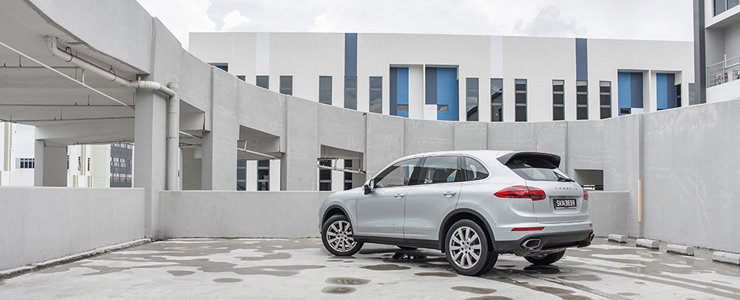 |
The Drive
Propelling the Cayenne Diesel is a 3.0-litre V6 turbodiesel unit. Output has been slightly bumped up to 258bhp - 13 more than before - while torque has increased by 30Nm to 580Nm.
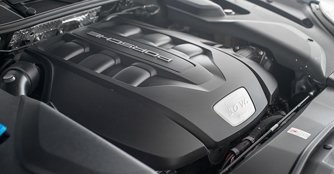
 The 3.0-litre turbodiesel helps the SUV complete the 0 to 100km/h sprint in a respectable 7.3 seconds
The 3.0-litre turbodiesel helps the SUV complete the 0 to 100km/h sprint in a respectable 7.3 seconds
While the oil burner is noticeably less refined than its petrol-driven sibling, the Cayenne Diesel is by no means punishing or frustrating to work with. Other than the slight drone during idling, there's less cabin intrusion once it gets up and going and will work well as a highway cruiser.
Expectedly, the diesel also feels less sporty than its petrol brethen, partly because it has a relatively shorter engine rev band. While the maximum torque of 580Nm is supplied from 1,750rpm, the surge tapers off as soon as it hits 2,500rpm. Hence, you'll need to 'search' for this band of torque if you want to overtake effectively.
Propelling the Cayenne Diesel is a 3.0-litre V6 turbodiesel unit. Output has been slightly bumped up to 258bhp - 13 more than before - while torque has increased by 30Nm to 580Nm.

While the oil burner is noticeably less refined than its petrol-driven sibling, the Cayenne Diesel is by no means punishing or frustrating to work with. Other than the slight drone during idling, there's less cabin intrusion once it gets up and going and will work well as a highway cruiser.
Expectedly, the diesel also feels less sporty than its petrol brethen, partly because it has a relatively shorter engine rev band. While the maximum torque of 580Nm is supplied from 1,750rpm, the surge tapers off as soon as it hits 2,500rpm. Hence, you'll need to 'search' for this band of torque if you want to overtake effectively.
However, if you drive the Cayenne Diesel in a more leisurely manner, it will 'reward' you with a respectable fuel economy of 11km/L - close to what the BMW X5 30d has to offer.
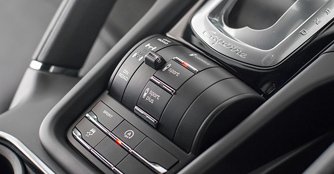
 Thanks to adjustable chassis setting, the more practicality-inclined Cayenne can still reward drivers with sporty handling
Thanks to adjustable chassis setting, the more practicality-inclined Cayenne can still reward drivers with sporty handling
Conclusion
If you're looking for more performance, Porsche is offering the sportier 'S' variant, with a 4.2-litre V8 turbodiesel that churns out 380bhp and a wholesome 850Nm of torque.
There's also the Cayenne Turbo with no fewer than 512 horses, and a top-of-range Turbo S due in the near future, which you can expect even more power.
But unless you want to 'kill an ant with a sledgehammer' or you're ready to part with a hefty sum of cash, the Cayenne Diesel is easily the most sensible pick of the lot.

Conclusion
If you're looking for more performance, Porsche is offering the sportier 'S' variant, with a 4.2-litre V8 turbodiesel that churns out 380bhp and a wholesome 850Nm of torque.
There's also the Cayenne Turbo with no fewer than 512 horses, and a top-of-range Turbo S due in the near future, which you can expect even more power.
But unless you want to 'kill an ant with a sledgehammer' or you're ready to part with a hefty sum of cash, the Cayenne Diesel is easily the most sensible pick of the lot.
It was once said that people wouldn't be interested in a Porsche unless it has a 'pancake' motor mounted on the wrong side (at the rear) of the car.
In fact, earlier models, such as the 914 - a two-seater roadster, which was the result of a joint project with Volkswagen, and the lineup of front-engined sports cars, ranging from the 924 to the 968 - were nowhere as successful as the 911.
But it seems that the tide has changed. When Porsche launched the Cayenne SUV, brows were raised but the car became a sales success overnight, outselling sporty models like the Boxster and Cayman, and even the iconic and highly desirable 911.
Now in its second generation, the Cayenne remains to be one of the marque's best-selling models. But while the facelift version is available in no fewer than six 'flavours', there should be no doubt that it's this diesel variant that will top the sales chart.
Up close and Personal
Much of the Cayenne's proportions and design have been left unchanged in this latest iteration. Despite sporting a more angular look (thanks to the redesigned air inlets and crisp lines running down its bonnet), the SUV isn't overly sporty by any measure.
In fact, earlier models, such as the 914 - a two-seater roadster, which was the result of a joint project with Volkswagen, and the lineup of front-engined sports cars, ranging from the 924 to the 968 - were nowhere as successful as the 911.
But it seems that the tide has changed. When Porsche launched the Cayenne SUV, brows were raised but the car became a sales success overnight, outselling sporty models like the Boxster and Cayman, and even the iconic and highly desirable 911.
Now in its second generation, the Cayenne remains to be one of the marque's best-selling models. But while the facelift version is available in no fewer than six 'flavours', there should be no doubt that it's this diesel variant that will top the sales chart.
Up close and Personal
Much of the Cayenne's proportions and design have been left unchanged in this latest iteration. Despite sporting a more angular look (thanks to the redesigned air inlets and crisp lines running down its bonnet), the SUV isn't overly sporty by any measure.
In fact, it's easy to find more aggressive-looking models, such as the BMW X5 and Jeep Grand Cherokee, which make the Cayenne's rounded overalls looks tame in comparison.
It is also tough to tell the new version from its predecessor. The best way, perhaps, is from the reworked tail lamps, which look sleeker and feature more eye-catching four-point braking lights.
Porsche seems rather obsessed with buttons, with almost all of the area of the centre floating console filled by tiny switches. Thankfully, they are cleverly grouped, which makes them easy to find.
It is also tough to tell the new version from its predecessor. The best way, perhaps, is from the reworked tail lamps, which look sleeker and feature more eye-catching four-point braking lights.
Porsche seems rather obsessed with buttons, with almost all of the area of the centre floating console filled by tiny switches. Thankfully, they are cleverly grouped, which makes them easy to find.
The Drive
Propelling the Cayenne Diesel is a 3.0-litre V6 turbodiesel unit. Output has been slightly bumped up to 258bhp - 13 more than before - while torque has increased by 30Nm to 580Nm.
While the oil burner is noticeably less refined than its petrol-driven sibling, the Cayenne Diesel is by no means punishing or frustrating to work with. Other than the slight drone during idling, there's less cabin intrusion once it gets up and going and will work well as a highway cruiser.
Expectedly, the diesel also feels less sporty than its petrol brethen, partly because it has a relatively shorter engine rev band. While the maximum torque of 580Nm is supplied from 1,750rpm, the surge tapers off as soon as it hits 2,500rpm. Hence, you'll need to 'search' for this band of torque if you want to overtake effectively.
Propelling the Cayenne Diesel is a 3.0-litre V6 turbodiesel unit. Output has been slightly bumped up to 258bhp - 13 more than before - while torque has increased by 30Nm to 580Nm.
While the oil burner is noticeably less refined than its petrol-driven sibling, the Cayenne Diesel is by no means punishing or frustrating to work with. Other than the slight drone during idling, there's less cabin intrusion once it gets up and going and will work well as a highway cruiser.
Expectedly, the diesel also feels less sporty than its petrol brethen, partly because it has a relatively shorter engine rev band. While the maximum torque of 580Nm is supplied from 1,750rpm, the surge tapers off as soon as it hits 2,500rpm. Hence, you'll need to 'search' for this band of torque if you want to overtake effectively.
However, if you drive the Cayenne Diesel in a more leisurely manner, it will 'reward' you with a respectable fuel economy of 11km/L - close to what the BMW X5 30d has to offer.
Conclusion
If you're looking for more performance, Porsche is offering the sportier 'S' variant, with a 4.2-litre V8 turbodiesel that churns out 380bhp and a wholesome 850Nm of torque.
There's also the Cayenne Turbo with no fewer than 512 horses, and a top-of-range Turbo S due in the near future, which you can expect even more power.
But unless you want to 'kill an ant with a sledgehammer' or you're ready to part with a hefty sum of cash, the Cayenne Diesel is easily the most sensible pick of the lot.
Conclusion
If you're looking for more performance, Porsche is offering the sportier 'S' variant, with a 4.2-litre V8 turbodiesel that churns out 380bhp and a wholesome 850Nm of torque.
There's also the Cayenne Turbo with no fewer than 512 horses, and a top-of-range Turbo S due in the near future, which you can expect even more power.
But unless you want to 'kill an ant with a sledgehammer' or you're ready to part with a hefty sum of cash, the Cayenne Diesel is easily the most sensible pick of the lot.
Car Information
Porsche Cayenne Diesel 3.0 (A)
CAT B|Diesel|14.7km/L
Horsepower
193kW (259 bhp)
Torque
580 Nm
Acceleration
7.3sec (0-100km /hr)
This model is no longer being sold by local distributor
All Used Porsche Cayenne DieselThank You For Your Subscription.




















